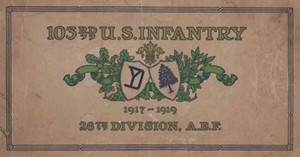 |
IN the early part of December, 1918, the Division Commander, Major General
Hale, at a conference at Montigny-le-Roi, expressed his desire that the several
organizations of the division take steps to properly record their history. An. order
on this matter soon followed, and it is in compliance with this order that (-he
following history or story of the 103rd Infantry has been written. Primarily
its purpose is to record the events, the actions, and the facts, concerning the
regiment from the time of its incorporation as a part of the 26th Division through
the close of the wnr. This primary purpose would be satisfied by a very few
pages of statistics and data, but it is thought that something more should be
given; for, just as any history would be dull if it contained nothing Qbut dates,
places, figures, and names, in the same measure would this story of the 103rd
Infantry be dry and uninteresting if the circumstances, the life, and the atmos-
phere surrounding the events should be omitted.
As a glance at the index shows, the history is divided into four main parts
following in natural sequence; lirst, :1 [brief sketch of_thc [National Guard units
which formed the regiment, their mobilization at Westfield, and thc departure
of the regiment overseas; second, thc period of preliminary instruction including
the time of debarkation in France and entrance in the lines; third, the period of
practical instruetion, covering the operations on the Soissons and Toul fronts;
and fourth, the period when thc division had become a combat ani! and covering
the Chateau-'l`hierry, St. Mihiel, and Verdun, or Mcuse—Argonne offeiisives.
The phrase "natural sequence" is believed to be used advisedly. The first; para-
graph of our Infantry Drill Regulations states the object of military training to
he as follows: "Success in battle is the ultimate object of all military training;
success may be looked for only when the training is intelligent and thorough."
Net until the regiment had passed into this stage of being a combat unit, been
put to the practical test of offensive Warfare, and been successful, had this object
been attained.
Each of the preliminary stages was important; to each period will be given
the consideration it deserves annl, though relatively speaking, all of the events
since August, 1917, are so near in point of time as to preclude a distant perspec~
tive, which might result in the omission of some details, this lacl; or error should
be more than eounterbalanced by the fact that now is the time when the sources
of information are best available. In regard to this matter of inf mation it
should at the outset be understood that oH·icers and men throughout tiibqgiment
have been called upon to assist, and have assisted, in compiling such facts as are
here recorded, and to them are due more than " the customary acknoxvledgments."
CHARLES R. CABOT,
l\Ii».,vo1‘t 103nD INFANTRY,
Regimental H islori an
|
 |

